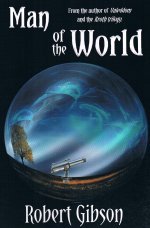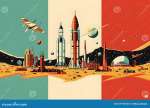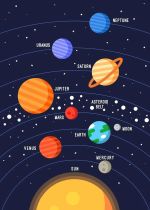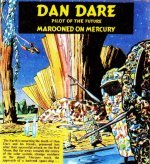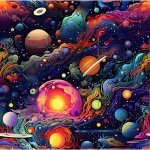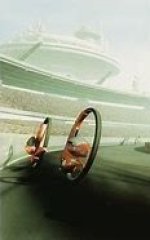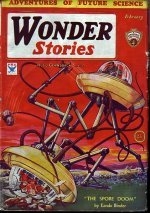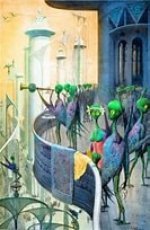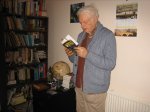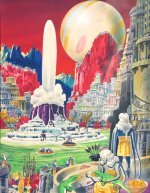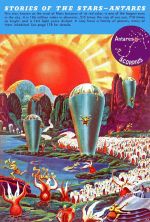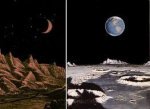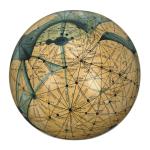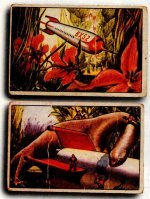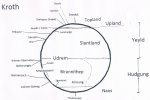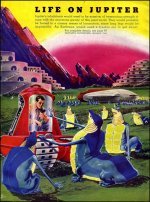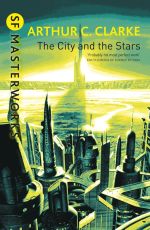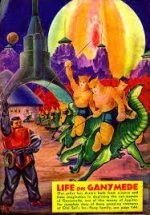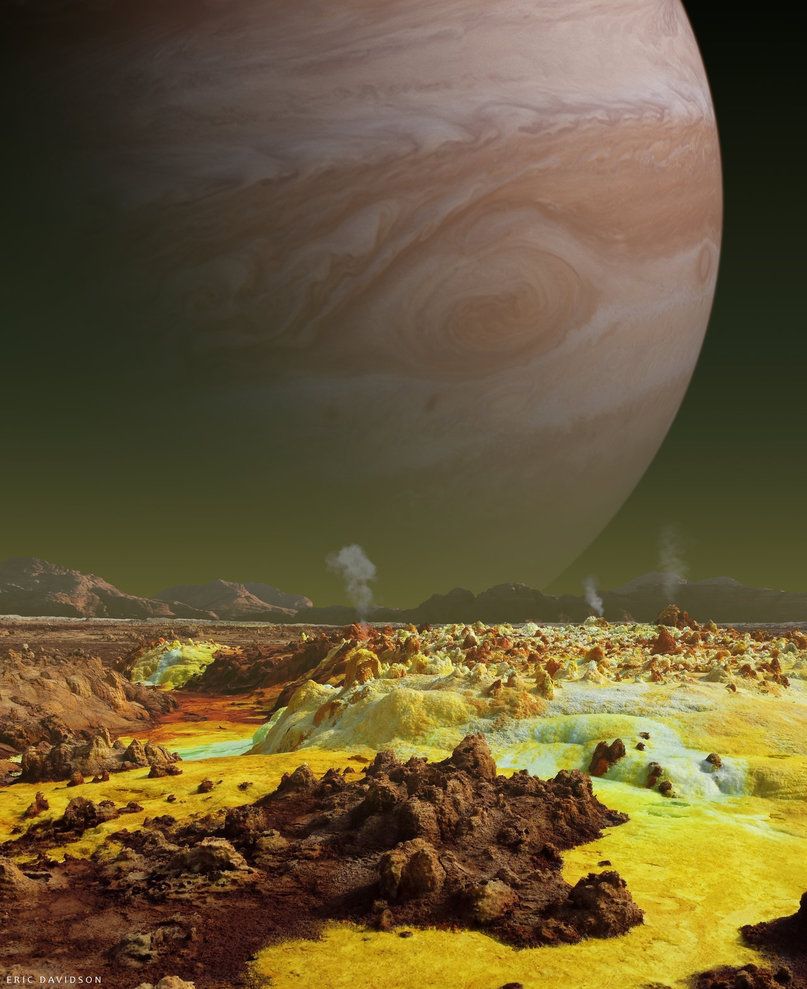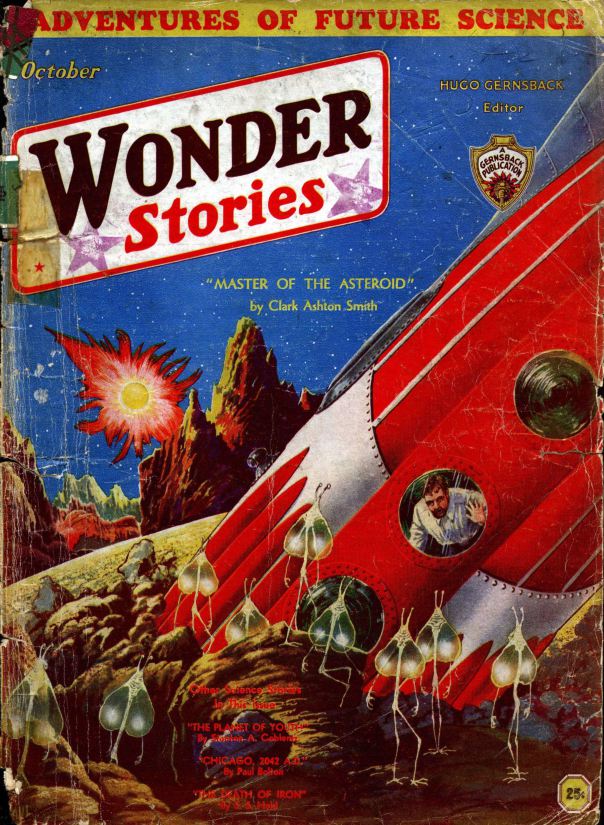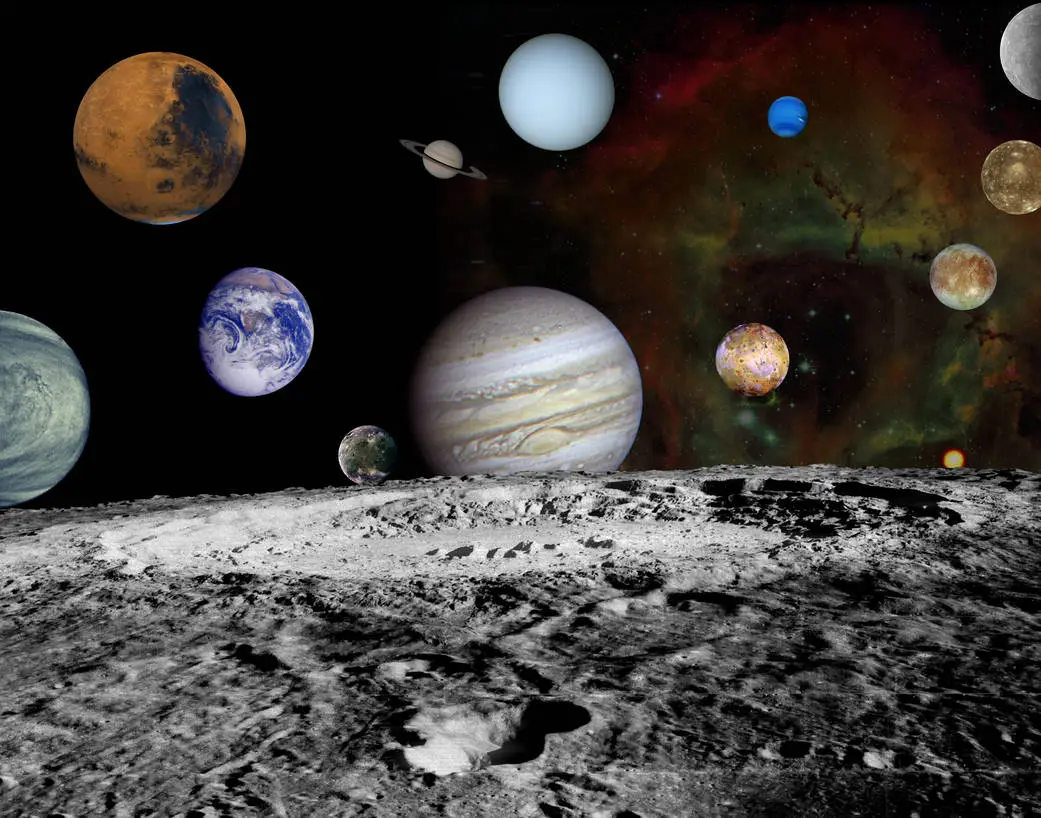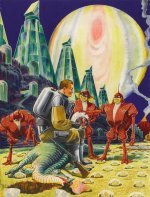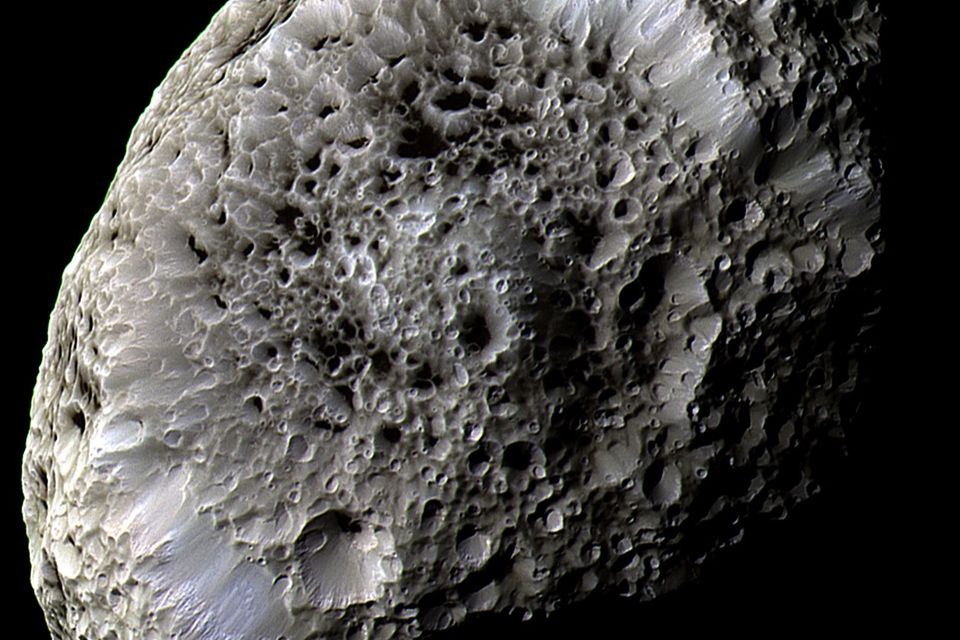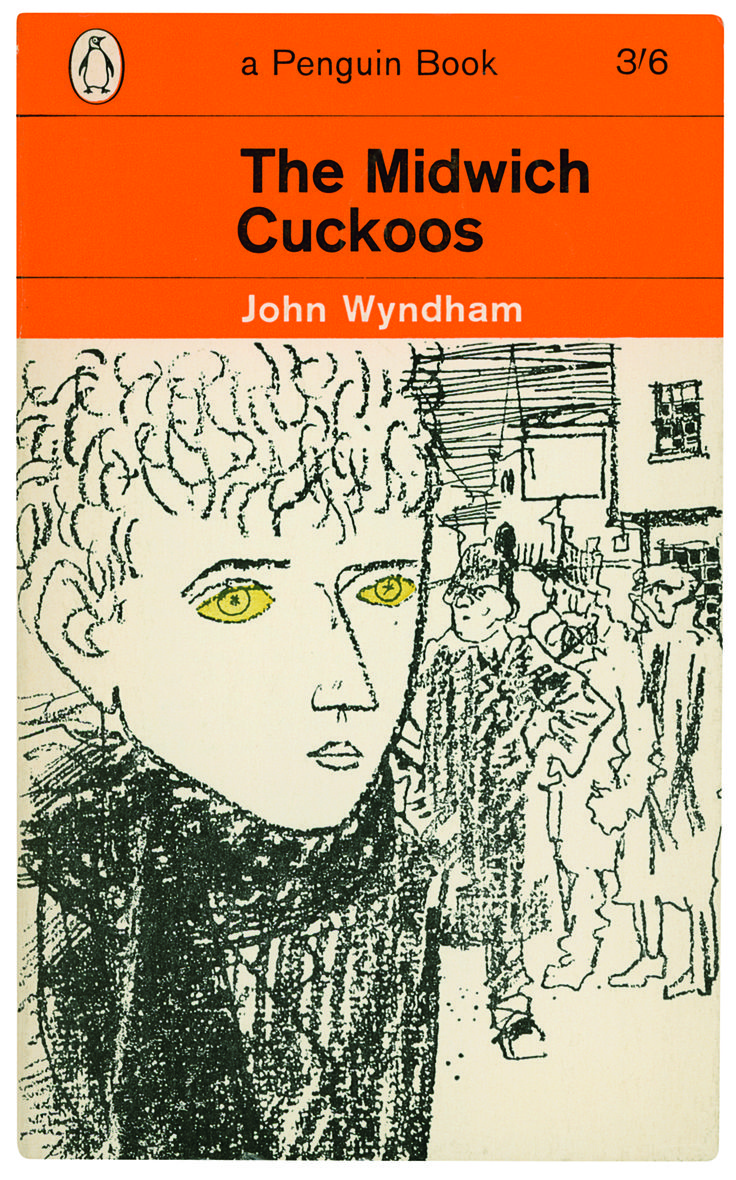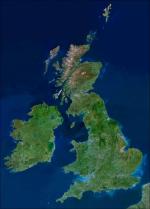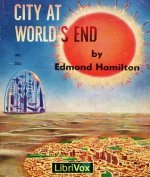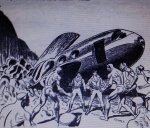a brief history of ooranye
3: the lithium era
[continued from 2: Syoom and Fyaym ]

The digestion of Dzolm
Picture a mountain covered with men wielding pickaxes, drills, hammers, and, as time goes on, mechanical contrivances to split and hew and carry off pieces of glowing orange stuff, which is borne away on trails of transport like lines of ants carrying material for their colonies. As a result the mountain gradually shrinks as the days flow by in their thousands and millions.
This is as good a way as any to imagine this era, which was the great age of Dzolm, the Sun-Egg (and of the glory of Contahl, the city closest to Dzolm).
To fill in more of the detail in your picture you must think of the Dzolm itself as a huge part-buried sphere, six hundred yards in diameter, composed of that glowing orange matter known as semi-kolv or gvo. Imagine that at the start it is covered with a layer of ice and rock, which was the old surface of the ground, pushed by the mascon’s up-thrust to reveal the Dzolm’s sphericity, like skin distended over a subcutaneous swelling. That’s at the start of the era.
As the days go on, more and more of the sphere of precious gvo is excavated. The Sun-Egg is being eaten away by civilization, which digests it in the form of power to create fleets of airships, factories, machine-tools, weapons, construction projects, laboratories, hover-rafts, lighting systems and all the paraphernalia of a technological society, the like of which had not existed before on Ooranye.
Contahl, the noadex and renl
The Lithium was a medium-length era, 5,610,292 Uranian days. At the equivalent of 19,200 Earth years, this of course amounts to a period much longer than the whole of human history on Earth. Yet to the Uranians of today the Lithium Era is a shadowy period, almost as if it were mere proto-history like our idea of Archaic Greece. The main reason for this is that in Era 3 we are not yet arrived at the characteristic Uranian disc-on-stem cities which first appear in the brilliant and mighty Phosphorus Era to come. Yet the Lithium Era did have Contahl – which still exists today, proud of its immense past, and of its later refusal of the disc-on-stem design. From the mid Lithium Era onwards, a traveller who sights Contahl sees first what looks like a lattice-model of a giant half-egg standing on end – a living reminder of the pre-Phosphorus type of city. (So far as we know, the structure was not built in imitation of the Sun-Egg, which was spherical rather than ovoid.)
Enormously more important than physical design is the fact that it was in Contahl that the level of complexity was achieved, which gave birth to the distinctive Uranian political organization, the noadex, and the social quality known as renl – adjective lremd.
The noadex – “noadship” – is the rank and rule of the Noad, or focus, of a city. The Noad is supposed to govern without bureaucracy; instead, nen relies upon sheer talent or instinct for knowing what to do. Some possess that talent or instinct, others do not. Therefore, in sane periods of history, political ambition is constrained by that simple reality. There is no point in trying to become a Noad if you are not Noad material, because you won’t have the abilities to last, and if you are Noad material you will probably get there, sooner or later. Widespread admission of these truths greatly reduces the undignified scramble for power.
About this “knowing what to do”: it is connected with what the Uranians call renl, the quality of being lremd, which applies to all Nenns, political or not. It is the socioeconomic equivalent of the talent we Earth-people used to need, in the days of dense population – the talent for hurrying along crowded pavements in the rush-hour without bumping into each other. We can steer in that way, instinctively, subconsciously. So do the Uranians – but they can do it in their economic and political life too. In a fashion which we can hardly imagine, the day to day running of a Uranian state is instinctive, like the functioning of an anthill, but with this difference, of course, that Uranians preserve their individual minds, which are often free to wander at leisure while they work.
The rise of the noadex and of renl was a gradual, organic process. It is more obvious to us now than it was at the time. It progressed steadily from Eras 3 to 15 – that is, from the Lithium through to the Phosphorus Era.
The threat of the Mawos
The people of Era 3 built a considerable civilization, but their success was maintained at high economic cost. In particular, they had to keep up an enormous fleet of airships to patrol the skies of Syoom.
As has previously been noted, at the same time as humans first appeared on Ooranye the sivvan also gave birth to the aerial micro-organisms whose pulsations provide the current day/night cycle on the dim giant planet. Unfortunately for humanity, a much larger relative of these tiny creatures subsequently evolved. These were the Mawos, aerial corpuscles about wardrobe-size and shape, though fuzzy at the corners and light enough to drift on the wind.
If an area was left un-patrolled for too long, a dark floating fleck might appear, and a slab of darkness grow around it. Soon, a geometrical portion of blackened sky would bulk in the form of a cuboid, an octahedron or a parallelepiped, depending on which subspecies of Mawo was responsible; and after a while a sharp report would be heard, and seeds would rain down to create a swiftly growing forest of bulbous vrayns, the vegetable stage of the Mawo life-cycle. After which it would require an army to root them out…
The threat the Mawos posed to humanity was the threat of light-deprivation. To blacken huge areas of sky (by absorbing all bioluminescence within range) was to deprive ordinary plant life of the means of survival. Since, ultimately, humans depend upon plants, this could not be allowed to happen. And it was noted that the best way of preventing it from happening was simply to patrol the sky, since, for reasons which have never been made clear, Mawos do not operate in the visible presence of man, or (so far as is known) of any intelligence. It is doubtful if they are at all intelligent themselves; in fact, since evidence suggests that their dissemination in the Lithium Era was a direct result of man’s increased cultivation of the glowing ell-light fields, Mawos could be classed as merely agricultural pests. Yet like the locusts of Earth, they can be formidable foes.
What a cost to have to sustain – keeping up a presence in every bit of sky, patrolling so densely as to protect every field! It could not be done with one hundred per cent effectiveness, but even to achieve minimum viable clearance (seventy per cent) laid a great burden upon mankind’s resources, hastening the day when the Sun-Egg would be exhausted.
(Nowadays, the burden of coping with the Mawos is far less, for two reasons – airships are cheaper to run, and Mawos fewer in number.)
The Survival Race
Towards the end of the Lithium Era, the mind of Uranian humanity was concentrated upon the problem of how to achieve economic independence from the Sun-Egg before its substance was used up.
In the final Uranian years – the last few lifetimes – of the era, all Nenns were consciously in a race for survival, a race between research and catastrophe.
Diverse schools of thought grew up around the problem. We might class them broadly into the Respectables and the Loonies. The Respectables thought that the power-resource problem could be solved by a combination of retrenchment and research into modest alternatives, mundane resources such as burning wood, using wind power, using thermal power from the Jershan volcacoes, and concentrations of the biomass glow from ell-light fields.
The Loonies said that this was all very well but when the gvo from the Sun-Egg was all gone, mankind would find itself in far too exposed a position, far too prominent after hundreds of U-years of luxuriant power, for any scaled-down strategy to be viable. If the Nenns were to retrench, they would find themselves in the position of an army in battle unable to stop an orderly retreat from turning into a rout. There was no going back to Era 1. The only way was forward, into another form of high-energy society.
On Day 5,610,287 of the Lithium Era a pan-Syoomean congress met at Contahl determined to hammer out a solution to the resource problem.
The delegates included the Noads of every city. They met in front of a huge mural photograph depicting the current state of the Dzolm, or Sun-Egg, showing how depleted its outline had become. It was almost no sphere at all, only a jaggedness and an almost empty bowl where the gvo had reared its orange bulk in olden times. In less than a couple of U-years at the present rate of use even the remnant would be gone.
The “Loonies” or extremists won every debate. They won without propounding any useful suggestions themselves; they only needed to show that all the calculations of the “Respectables” were insufficient to demonstrate any hope. Moderate ideas were discredited; only radicalism remained to be tried.
After
five days a declaration of the results of the congress was issued to the public.
The shock was so profound that the emotional resonance affected the micro-organisms
in the atmosphere, altering their cycle of illumination so that the rhythm of day
and night hiccoughed in another eomasp, marking an era transition. Everyone
thus knew that the Lithium Era was over.

